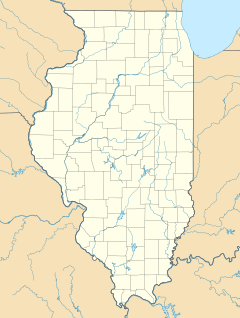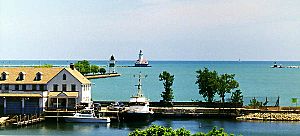Chicago Harbor Light facts for kids
 |
|
|
|
|
| Location | Chicago, Illinois |
|---|---|
| Coordinates | 41°53′22″N 87°35′26″W / 41.88936°N 87.59060°W |
| Year first constructed | 1893, moved 1919 |
| Year first lit | 1893 |
| Automated | 1979 |
| Foundation | Rubble stone with concrete pier |
| Construction | Brick, cast iron and glass |
| Tower shape | Cylindrical base/Frustum of a cone tower, with attached buildings |
| Markings / pattern | White, red on roofs |
| Height | 66 ft (20 m) |
| Focal height | 82 feet (25 m) |
| Original lens | Third-order Fresnel |
| Range | 24 miles (39 km) |
| Characteristic | Fl R 5s floodlighted. Apr. to Dec.
Horn: 2 blasts ev 30 s (1 s bl). Operates from April to Dec |
| ARLHS number | USA-171 |
| USCG number | 7-19960 |
The Chicago Harbor Lighthouse is an active lighthouse that works automatically. It stands at the south end of the northern breakwater, which is a wall built to protect the Chicago Harbor. You can find it east of Navy Pier and near where the Chicago River meets the lake.
Contents
History of the Chicago Harbor Lighthouse
When Was the Lighthouse Built?
The Chicago Harbor Lighthouse was first built in 1893. It was made for the World's Columbian Exposition, a big world's fair held in Chicago that year. The United States Lighthouse Board wanted to show off its newest inventions and engineering skills. They even displayed a tall, 111-foot (34 m)-tall metal lighthouse tower.
What About the Special Lens?
At the fair, many special Fresnel lenses were shown. One amazing Third Order Fresnel lens even won first prize at an exhibition in Paris, France. This lens had red and white panels that switched. It was supposed to go to a lighthouse in California.
But, when the new Chicago Harbor Lighthouse was finished, the fair was also ending. So, the Lighthouse Board decided to keep the special lens in Chicago. It was placed in the lantern room of the new tower. Later, the original lens was moved. You can now see it on display at Cabrillo National Monument in California.
How Does the Lighthouse Look?
The lighthouse stands on a base of rip rap, which are loose stones used to protect the structure. It has several parts:
- A strong concrete base.
- Two buildings with red roofs.
- A white, round tower that gets narrower at the top, between the buildings.
- A parapet (a low wall) at the top, just below the light itself.
When Was the Lighthouse Moved?
In 1917, the breakwater was updated. At that time, the lighthouse was moved to where it stands today. A fog signal room and a boathouse were also added to it.
The design of this lighthouse is quite special. It looks a bit like other "sparkplug" lighthouses that stand offshore, but it is taller. It also shares some features with the Rock of Ages Light on Lake Superior, which was built around the same time.
Is the Lighthouse a Historic Place?
Yes! The Chicago Harbor Lighthouse is very important.
- It was added to the National Register of Historic Places on July 19, 1984. This means it's recognized as a historic site across the country.
- It was also named a Chicago Landmark on April 9, 2003. This means it's a special historic place in Chicago.
In 2005, the U.S. Coast Guard said the lighthouse was "excess." This meant it could be given away for free to groups like local governments or non-profit organizations. This was done under a law called the National Historic Lighthouse Preservation Act of 2000.
After some time, the City of Chicago officially took over the lighthouse on February 24, 2009. The city had already made it a Chicago Landmark years before.
The important role of the lighthouse in Chicago's history is remembered in a relief sculpture called The Spirit of the Waters. You can see this artwork near the LaSalle Street entrance of Chicago City Hall.
Protecting the Lighthouse
Illinois has a few well-known and historic lighthouses, especially around Chicago. The Chicago Department of Water also takes care of lights on its four water intake cribs in the lake.
There isn't a specific group in Chicago just for saving lighthouses. However, the Chicago Harbor Lighthouse has received a lot of attention for its preservation. Other lighthouses, like the Calumet Harbor Light in nearby Indiana, have been torn down in the past. So, it's important to protect these historic structures.
Visiting the Lighthouse
The Chicago Harbor Lighthouse is still an active aid to navigation. This means it's still working to guide boats, and people are not allowed to go inside.
But you can get a great view of the lighthouse!
- One of the best places to see it is from the end of Navy Pier.
- Even better views can be had from a boat. Many tour boats in the area offer trips that pass by the lighthouse.





